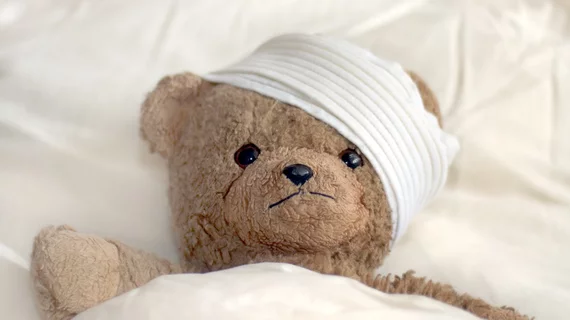Younger patients are routinely sedated during radiologic studies, requiring some kind of restraint to avoid unclear imaging from anxious fiddling or unconscious movement, but when is sedation actually appropriate? How can clinicians avoid it?
Lorie Reilly, MSN, CRNP, a sedation nurse practitioner at the Children’s Hospital of Philadelphia, wrote in the Journal of Radiology Nursing this May that while sedation sometimes seems like the sole option, it also comes with risks like apnea, oxygen desaturation, airway emergencies and prolonged recovery. Those possibilities, alongside reports of decreased safety, greater risks and climbing anxiety, sometimes make the option an unattractive one to parents.
“Remember that children are sensitive to the sights, smells, sounds, tastes and feels in the radiology environment,” Reilly said. “They are like sponges as they take in the world around them. Do not overwhelm them with everything all at once, but rather break things down into steps of what will happen from beginning to end.”
These are Reilly’s tips for a successful, non-sedated experience:
1. Tailor the game plan based on ages and stages.
What it takes for an infant to remain still differs widely from what it takes for an adolescent to do the same, Reilly wrote. Feeding, swaddling or using an immobilizer device might work on a baby, but even a toddler’s graduated from those fixes within a couple years. For toddlers, Reilly said offering them distractions that cater to their explorer identities—something like blowing bubbles—can keep them calm, while preschoolers might need more hands-on distractions, like medical play.
School-aged kids, who are “very concrete thinkers,” might be satiated with a movie, an iPad or some breathing exercises, while radiologists should cater to teens’ privacy and independence by asking them to bring their own music into the MRI suite.
2. Involve the parents.
The old adage is certainly a true one when it comes to sedation, Reilly said—parents really do know best.
“We cannot care for the children in the radiology areas without involving the parents in their care,” she wrote. “Parents know their children best, and the medical and nursing personnel are strangers to the children.”
For this reason, it’s important to always keep parents close, Reilly said. Keep them within viewing distance of their child, and, if possible, give them a job, like holding their son or daughter’s hand or singing to them.
3. Be mindful of your word choice.
Medical jargon might make perfect sense to the radiology staff, but all the terminology can come off as threatening and overwhelming to kids. To avoid using syntax that will go over young patients’ heads, and to keep them engaged, Reilly suggests using more descriptive speech, like calling the MRI machine a “spaceship.” Word choice makes a big difference, she said—“warm feeling” replaces the “burn” you feel from anesthetic, “cuts” and “slices” are “small openings,” and an IV catheter is just a bendy straw.
4. Adhere to “ONE VOICE” guidelines.
The acronym ONE VOICE, which was designed to create a less threatening medical environment for kids, is used to remind clinicians that: only one voice should be heard during the procedure; the child needs parental involvement, the patient needs to be educated about process and expectations prior to a procedure, the child should be verbally validated and in the most comfortable, non-threatening physical position, game plans should be individualized, distractions should be chosen appropriately and that people not necessary to the procedure should be removed from the room.
5. Consider a child life specialist.
Before defaulting to sedation, Reilly said it could be important to consider a child life specialist in the case. Child life specialists are professionals who promote the emotional well-being of children by prepping them for procedures like MRI and arming them with coping strategies.
“They represent the glue that keeps things together for children and families and allows us to provide comprehensive care to children in an environment that may invoke fear and anxiety,” Reilly wrote.

